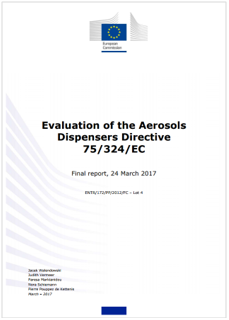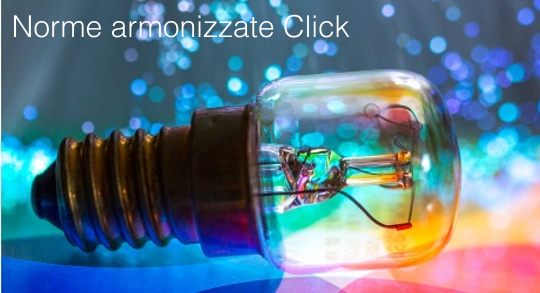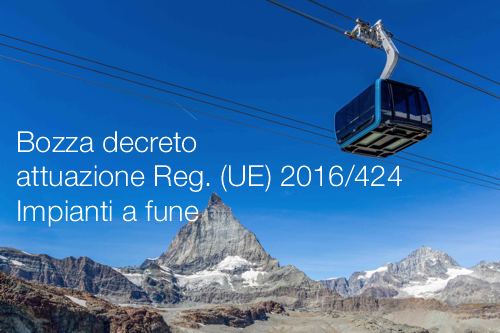
Evaluation of the Aerosols Dispensers Directive 75/324/EC
Final report 2017
The Aerosol Dispensers Directive (ADD) (75/324/EEC) is one of the oldest EU legislations related to product safety. This Directive includes specific requirements related to pressure hazard and flammability as well as a general obligation to analyse all hazards which could apply to an aerosol dispenser product. Based on such analysis, the aerosol is designed, constructed and tested accordingly to fulfil the appropriate safety requirements concerning its use.
The ADD has two objectives:
1. Guaranteeing that products within the scope of the ADD are safe for consumers/ other users in respect of hazards related to pressure and where appropriate, flammability and inhalation.
2. Securing the free movement of aerosol dispensers throughout the EU. As such, Member States must allow the marketing on their territory of aerosol dispensers that comply with ADD.
The ADD is a so-called "old approach" directive including very detailed technical requirements regarding labelling, manufacturing, and testing, etc. The Directive has never seen a complete revision, but several amendments were made over time. These modifications were of technical nature to accommodate changes in technology (e.g. allowing safely increasing the pressure in containers resulting in better performance of the aerosol dispenser products) or to ensure coherence with other legislation (e.g. related to the labelling requirements of the Regulation on classification, labelling and packaging of substances and mixtures, known also as the CLP Regulation).
Since its adoption in 1975, the ADD has not been subject to a formal evaluation. While the overall perception of the Directive is positive, the European Commission felt that a rigorous evaluation should assess whether this perception reflects the real situation.
The evaluation aimed at assessing the relevance, effectiveness, efficiency, coherence, and EU added-value of the ADD. It covered the EU28 Member States.
The evaluation relied on data from several primary and secondary data sources. These consisted of desk research (including a full market analysis of the European aerosols sector), interviews with key stakeholders (European and national authorities, industry, and consumer organisations), a targeted online survey for economic operators, and an open public consultation.
The scope of the evaluation will be an overall evaluation of the performance of the Directive. The results and findings of the evaluations will provide information to the Commission services as to whether a revision of the ADD is required. The evaluation covers all Member States and the period 2005 to 2015, although in specific cases it was necessary to take into account the situation before this period in order to be able to evaluate some aspects.
The study focused on aspects regulated by the ADD itself. A clear distinction is made between aspects in the scope of the Directive and those governed by other legislation applying to aerosol dispensers but which are outside the scope of this evaluation (such as for example packaging, environmental, foodstuff or pharmaceuticals) Specifically this concerns aspects of hygiene, specification of raw materials that can be part of aerosol formulations, specific test methods concerning product performance, efficacy, claim substantiation, toxicological profiles, environmental aspects, like recycling, waste and waste management, etc. A high number of different economic operators are involved in the development and distribution of the aerosol products. They represent the persons responsible for marketing of aerosols and their professional associations where specific industry standards are being created and aligned, e.g. dimension of cans, orifices, valve diameters, actuation forces, pressure resistance levels of standard packaging, etc.
Most important stakeholders are the economic operators and their professional associations, the public authorities and the users of these products (i.e. consumer or industrial users and their professional associations)
...
Table of Contents
1. EXECUTIVE SUMMARY
1.1. The Aerosol Dispensers Directive
1.2. Objectives and approach to this evaluation
1.3. Main findings and conclusions
2. INTRODUCTION
2.1. Purpose of the evaluation
2.2. Scope of the evaluation
3. BACKGROUND TO THE INITIATIVE
3.1. Description of the initiative and its objectives
3.2. Baseline
3.3. Market analysis
3.4. Competitiveness – preliminary insights
4. EVALUATION QUESTIONS
4.1. Evaluation criteria and questions
5. METHOD/PROCESS FOLLOWED
5.1. Studies used
5.2. Sources of information/data
5.3. Steering group
5.4. Overall approach
5.5. Stakeholders consultation
5.6. Costs and Benefits
5.7. Limitations – robustness of findings
6. State of play of the implementation (Results)
6.1. Implementation
6.2. State of play
6.3. Unexpected results
7. ANSWERS TO THE EVALUATION QUESTIONS
7.1. Context
7.2. Relevance
7.3. Effectiveness
7.4. Efficiency
7.5. Coherence
7.6. EU Added Value
8. CONCLUSIONS
8.1. Background
8.2. Relevance
8.3. Effectiveness
8.4. Efficiency
8.5. Coherence
8.6. EU Added Value
8.7. Other
9. ANNEXES
ANNEX 1 - Study contract - terms of reference
ANNEX 2 - Bibliography
ANNEX 3 - Challenges related to the quality of spray and the performance of the dispenser during its use
ANNEX 4 - FEA standards and guidance documents
ANNEX 5 - Market analysis complementary information
Annex 6 - Evaluation grids
Annex 7 - Interview guidelines
Annex 8 - Targeted online survey
Annex 9 - Public consultation
Annex 10 - Costs grids.
Annex 11 - Overview of consultation with stakeholders
Annex 12 - Cost assessment
Fonte: Commissione Europea
Correlati:
Direttiva 75/324/CEE
Regolamento CLP Testo Consolidato
Allegati
|
Descrizione |
Lingua |
Dimensioni |
Downloads |
 |
|
EN |
1944 kB |
5057 |



































